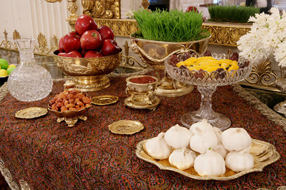
A White House Persian New Year table, prepared by Laura Bush |
Buzzwords appears each Friday on the Wide Angle blog and breaks down the lingo, jargon and hot topics of the world’s headlines.
Erin Chapman
Yesterday, President Obama released a video message to the people and government of Iran, asserting his administration’s commitment to pursuing diplomatic relations. Appropriately, this message calling for a “new day” in U.S.-Iranian relations was timed to coincide with Nowruz (or Norouz) — the Persian New Year and celebration of the first day of Spring.
Nowruz is a secular holiday with roots in the Zoroastrian religion, celebrating fertility and renewal and dating back thousands of years to ancient Persian kings.
Today, Nowruz is celebrated mainly in countries formerly belonging to the Persian empire – Iran, Afghanistan, Tajikistan, etc. It’s a public holiday in Iran, celebrated without the classiness of grown men dancing around in 2009 glasses and giant diapers. Families prepare for the holiday by doing some spring cleaning, getting haircuts, buying new clothes for the new year (jcrew.com/nowruz gets unbelievable hits in the month before) and brightening up the place with flowers. On the last night of the old year, celebrants build outdoor fires and jump over them in an effort to rid themselves of bad spirits. The new year’s festivities continue for twelve days during which families make short visits to their friends and neighbors.
To welcome all these guests, families set up a table with what’s known as the Haft Sin — seven items starting with the Persian alphabet letter “S.” This doesn’t mean you can fill up dishes with Spaghettios, s’mores, salami, salad dressing, sauerkraut, Stove Top Stuffing, and Skittles and call it a day. Specific “s” items are called for. These are: sabzeh – sprouting wheat, barley or lentil; samanu – sweet pudding; senjed – dried fruit from a lotus tree; sir – garlic; sib – apples; somaq – sumac berries; and serkeh – vinegar. On the table, you might also find objects that are thought to bring wealth, luck and health – coins, candles, a mirror, a holy book, rosewater, and decorated eggs among them. There’s sometimes even a bowl of goldfish symbolizing the sign of Pisces, which the sun is leaving.
The Easter bunny — a complex creature who heralds Spring by hiding eggs to mark Jesus’s return from the dead — has his Persian counterpart in Hadji Firouz. Hadji Firouz is portrayed by a man who paints his face black, wears a red costume and marches through the streets during Nowruz, singing and playing an instrument to welcome in the New Year.
On the thirteenth day after all this visiting and dried fruit-eating, families head outdoors for a final day of picnicking and carousing. The sprouts that have been growing on the Haft Sin — and soaking up all the bad stuff in the household — are thrown into running water to exorcise demons. It’s an Iranian horror movie waiting to happen — Exorcist IV: The Sprouting.
According to the Persian calendar, this most recent Nowruz marks the beginning of 1388. Only six hundred years to go before the Persian version of George Michael has a top forty hit!
